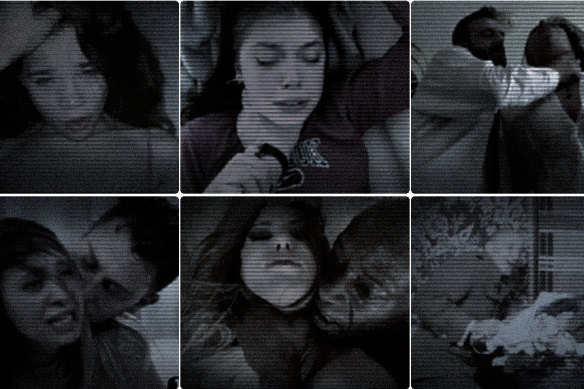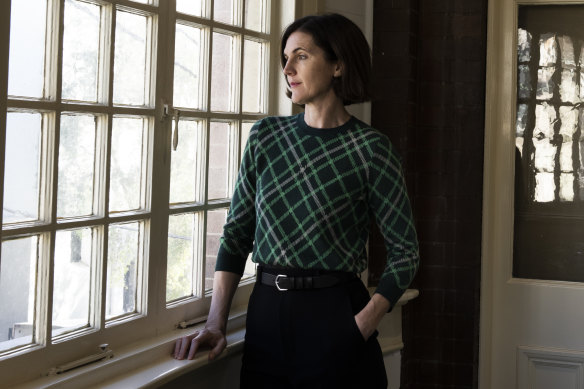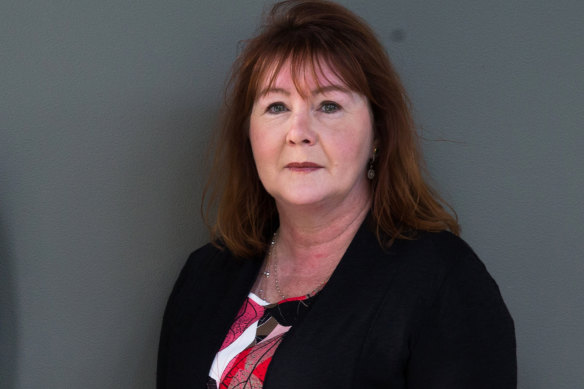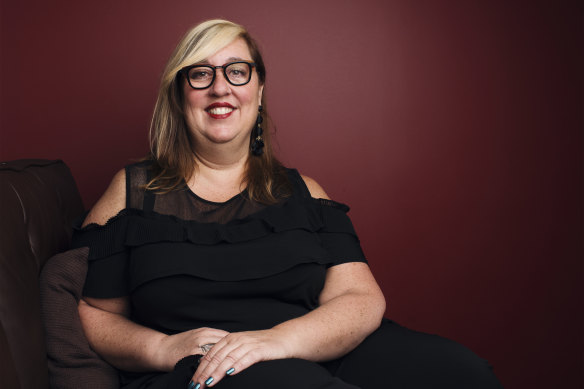This was published 2 years ago
‘I was 13. I thought that’s what was expected of me’
Young teenagers are increasingly committing - and being subjected to - extreme sexual acts. And unfettered access to violent porn is at the heart of the problem.
By Jordan Baker

Porn is readily influencing teenage boys.Credit: SMH
WARNING: Some readers may find images in this report distressing.
Three clicks. That’s all it takes to move from a popular adult site’s homepage to a video in which men dressed as soldiers rape a screaming “village girl”. Three more clicks and there’s a naked teenager crying helplessly as a man puts his hand around her neck against her will.
The videos are free. And none of the world’s most popular porn sites visited by this masthead, which show men treating women with violence and coercion prohibited under Australian law, stipulated the content was for adults, or required users to check a box confirming that they were over 18.
Amid deepening concern that adolescents’ easy, free access to a vast array of adult material is normalising gendered violence in adolescent sex – some teens say their first sexual experience involved a hand around their neck – the nation will soon begin debating whether to restrict access to minors. Those concerned include the NSW’s Children’s Court president and the head of the state’s child abuse squad.
The eSafety Commission has handed in its report on how Australia could introduce an age verification road map to the federal government, a move that could also restrict children’s access to violent gaming and gambling. Age restriction can range from government-issued “certificates” to technology that scans a user’s facial characteristics to assess their age. The government is due to respond soon.
There are similar moves overseas, sparking clashes between children’s advocates and civil libertarians, and leaving adults worried about having their own porn habits exposed. France is pushing ahead with a porn passport. The United Kingdom is still working on its years-long attempt at an “age-gating” system. Several states in the US are enacting their own versions. Earlier this month, Pornhub retaliated in one US state by blocking its content to all users.
Teens at the coalface
In Australia, where nearly half (48 per cent) of young men have seen pornography by the age of 13 and nearly half (48 per cent) of young women by 15, age-based internet restriction is backed by health workers, academics and justice officials who have seen the trauma that can come as a result of adult content being re-enacted by teens too inexperienced and immature to understand the difference between reality and fantasy, and too nervous about peer disapproval to resist.
But others say the horse has bolted – there’s an estimated 10,000 terabytes of adult content on the internet – and the best way to minimise harm involves parents and schools teaching young people that porn is not real, that it’s okay to say no to rough practices, and that there’s nothing wrong with “vanilla” sex. They fear further regulation would push porn underground.

Examples of violent pornography easily accessed on the internet.Credit:
The days of paper bags in newsagents are long gone. The biggest players in the multibillion-dollar online adult industry are shadowy aggregator sites, which, using the same US law relied upon by Facebook, argue they are platforms, not publishers. They make billions through advertising and data collection, using content made by other people. The world’s top three adult sites are visited by an estimated 5.81 billion people per month (they do not release their figures), almost twice as many as Facebook.
When this masthead visited those sites, one featured 16 homepage videos of which four were from the popular “faux-cest” genre; “fake” incest involving sex between teen step-siblings or adults and their stepchildren (“Daddy f---s his cute stepdaughter, don’t tell her mom”). There are explicitly racial subgenres, as well as a “rough” category featuring headlines such as “black sl-t endures extreme rough, painful f---.”
It is easily accessible and “perfectly free”, said Maree Crabbe, the project director for violence prevention initiative It’s Time We Talked. “You could be eight years old and look at it all day.”
Some dispute a causal link between adolescents viewing pornography and real-life harm. “This is a contested area,” said Mish Pony from the Scarlett Alliance, the peak body representing sex workers. However, research in Australia and overseas is leading to a growing consensus among academics and health workers that, for some teens, easy access to violent porn is normalising acts that, in the hands of fumbling teenagers, can be dangerous and traumatising.
One 16-year-old girl, speaking with the permission of her parents, explained how pervasive pornography has been during her high school years. Boys at her school watch it in classrooms, hot-spotting off their phones. “I get it sent to me,” she said. “The guys that I was with, talking about it all the time, to me. Talking about what they watch, and I felt I had to live up to that. And I’d think, ‘that looks so uncomfortable and painful’.”
Another said she dated a boy with a browser app specifically for pornography, which he’d watch at school and outside. “He used to watch the hardcore-porn type of thing, the rough stuff,” she says, which included BDSM (bondage, discipline, sadomasochism) and “the idea of consensual non-consensual stuff [role play that mimics forced sexual activity]. I was 13. I thought that’s what was expected of me. I know some boys don’t watch porn, but the majority do.”
The teenage girls said they had assumed choking, hair pulling and verbal degradation – they had experienced all three – were standard in sex even though it made them uncomfortable, and that pain and faked pleasure were part of the experience, until they spoke to trusted adults.
One 24-year-old woman reflected on her early sexual experiences with anger, saying copying porn is now normal for teenagers, and some – like her – participated in sexual activities they did not find pleasurable to avoid peer disapproval and accusations such as “kink shaming”.
“Acts like choking and strangulation and weird non-consensual violence that comes out of nowhere were common,” she said, speaking on the condition of anonymity due to the personal nature of her comments. “It happened when none of us had a vocab to articulate our desires or assert our boundaries.”
Changing violence before the courts

Nell Skinner is troubled by allegations she is hearing.Credit: Louise Kennerley
While juvenile sexual assault rates have been stable for the past 10 years, and there is no data on the types of sexual assault allegations coming before the NSW Children’s Court, the president of the court, Nell Skinner, says the nature of the allegations she has dealt with has changed “significantly” over the course of her 25-year career.
“My recollection from prosecuting and representing offenders between 2000 and 2009 is that sexual assaults predominantly occurred through digital or penile/vaginal penetration,” she said.
“Over recent years I have seen more matters in court where complainants give evidence of sexual assaults through oral sex, anal sex and choking. I believe this evidence represents changes in the behaviour of adolescents due to the accessibility of pornography and the incidental sex education that flows from exposure to pornography.”
Detective Superintendent Linda Howlett, the Child Abuse Squad commander, said she had seen a rise in sexual assaults involving choking, particularly in the past 18 months. Sometimes it’s due to dangerously clumsy auto-erotic asphyxiation but mostly “it’s the element of control”, she said, “the physical domination of another”.
It left victims traumatised. “We are seeing [underage victims] with soreness to their throat, bruising. It’s a disturbing trend. A lot of them feel that they’re actually going to die because they are not getting air into their airways,” Howlett said.
A landmark NSW Health report on preventing and responding to problematic and harmful sexual behaviour (PHSB) by young people, published in February, states that pornography and other sexually explicit material “contributes to sexual violence”.

Linda Howlett has seen a rise in sexual assaults involving choking.Credit: Janie Barrett
Another NSW Health report found exposure to pornography was one of the four common factors behind adolescent problematic or harmful sexual behaviours. The others are experiences of abuse, trauma and gender expectations. “There needs to be a specific focus on online safety and preventing early exposure to pornography,” the report said.
“There is evidence that pornography can negatively impact children’s mental health and wellbeing, their knowledge, attitudes, beliefs and expectations about sex and gender, and their involvement in risky or harmful sexual practices or behaviours.”
NSW Health has expanded its PHSB counselling services across the state, due to demand.
In two children’s court sexual assault cases last year covered by this masthead, both involved choking. In one case, the boy was found guilty of assault for putting his hands around the girl’s neck with so much force she fell back against the wall and struggled to breathe.
Research from the United States is showing increasing prevalence; one found that 13 per cent of sexually active girls aged between 14 and 17 have already been choked during sex.
“Young person after young person told me it was just a normal part of sex,” said Crabbe, who is preparing a campaign on strangulation after her recent interviews with young people – she has been doing them for 14 years – showed a new level of normalisation. “Young people [are] saying it often happens without any discussion or consent.”
Reflecting on the impact of pornography on her sexual development, another woman, aged 25, said: “Young women get victimised by porn but it’s not cool to be anti-porn. I’ve had to do a lot of unlearning about the things I told myself I enjoyed; I really only ‘enjoyed’ them because it was likely the person I was sleeping with would tell people that ‘she was really good in bed’.”
One man, in his 20s, said he first saw porn when he was in year 7, and was shown it by older boys. “It was not done in a sexual way,” he says. “I remember being shocked and confused and repulsed.” He said there was plenty of healthy porn available, but some types “highlight and overexposes certain types of sexual behaviours; dominance of men over women, a lack of female pleasure, a lack of any aftercare or post-sex experiences and, particularly problematically, a lack of consent.”
‘Indoctrinated from a young age’
Consent activist Chanel Contos said the normalisation of gendered violence left her with doubts about “young people’s capabilities to truly consent to these sorts of sexual acts when they’ve been so indoctrinated by pornography from a young age”.

Chanel Contos says we need to focus on access.Credit: Liliana Zaharia
The meaning of “vanilla” sex has changed, said Contos. “[It] means sex that’s free of choking, slapping. It’s sex that’s free of violence. And it’s [considered] lame.” She advocates a focus on access by minors. “That’s where the true problem comes from.”
So does the Children’s Commissioner, Anne Hollonds, who acknowledged the challenges involved in age assurance technology, such as privacy concerns, but said action was imperative to protect children, many of whom are accidentally stumbling upon it when they are pre-teens. She likened it to the introduction of seatbelts, which was controversial at the time.
“These online platforms of various kinds have been like the Wild West – anything goes for profit,” she said. “Unfortunately it’s always kids, and particularly more vulnerable kids, who end up suffering; the kids who don’t have the support or the supervision of parents to help them navigate these sorts of situations.”
Skinner said there were different ways a society could respond to the problem – through health, welfare, education or justice – “but the imperative is to acknowledge and address harm and reduce the risk of future harm”, she said.
She said education was important, and regulation – as proposed by the eSafety commissioner – was needed to reduce access to pornography. “Adolescence is a difficult developmental stage where young people struggle to understand and communicate their sexual needs,” Skinner said.
“The eSafety commissioner has a unique ability to regulate access and review content, and this intervention will reduce exposure to pornography and limit the influence of negative messages about sexuality.”
How to tell if pornography is “healthy”
Sydney University researchers identified six criteria that could be used to identify healthy and ethical pornography. They include:
- A negotiation of consent onscreen
- Depictions of safe sex
- Ethical production
- A focus on pleasure for all participants
- A variety of sexual practices
- A variety of body types, genders, and races
However, Tanya Koens, a pleasure activist who presents a sex program on FBI radio, said that while she was concerned about the way some pornography condones violence against and degradation of women – and believes that type of content is made by “angry white men who can’t get laid” – regulation was not the answer.
“Taking porn off the table is not going to happen,” she said. “I think we’re at a harm minimisation approach.” Moreover, porn was not the only place people were absorbing the message that sex is about power, she said; it’s also coming from movies, advertisements and interactions between adults in their lives.

Tanya Koens says we should take a harm minimisation approach.Credit: James Brickwood
Young people should be taught, “do not re-enact the porn, it’s not real”, said Koens. “You need to know yourself well before you get into this stuff [such as choking and anal sex]. Going into kinky things before you know how your body works is [like] trying to run before you walk. We can teach people to be ethical consumers of porn. The problem is that the free stuff is the shit stuff.”
Pony said insufficient attention was paid to the reasons why material was potentially harmful to young people. “Is it because we’re not providing comprehensive sexual health education, and we’re not equipping people to deal with content they find on the internet, and that will always be accessible? People will always work around [age verification].”
A spokeswoman for Communications Minister Michelle Rowland said the government would consider the eSafety commissioner’s advice and outline the next steps in coming months.
“We live in an era where many children have greater skills with technology than their parents – so we need a multifaceted approach to protecting children from online content that is not appropriate for them,” she said.
“The Online Safety Act 2021 requires the development of new industry codes to limit children’s exposure to pornography, led by the eSafety commissioner, with development of the codes to commence later this year.
“Parents and carers may feel overwhelmed by this issue, but they are not powerless. There are a range of tools available including internet filters, hardware devices and parental controls.”
Under Australian classification law, all sexually explicit material is classified X 18+ and unsuitable for a minor to see. Viewing pornography in private is not prohibited at any age, as long as the content is not illegal (such as child pornography). However, sharing it with (including in homes), showing it to, or selling it to people under 18 is against the law.
The Morning Edition newsletter is our guide to the day’s most important and interesting stories, analysis and insights. Sign up here.